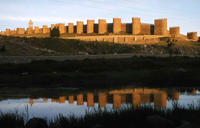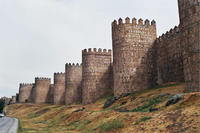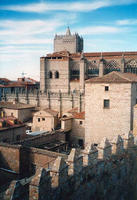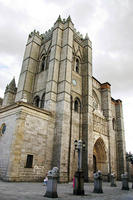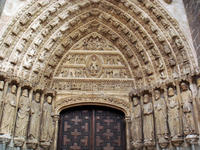You are in: Europe -> Spain -> Old Town of Ávila w... , and traditional search or Image Gallery will yield results of this site only
Old Town of Ávila with its Extra-Muros Churches
| Site number: | 348 |
|
| Type of site: | Cultural | |
| Date: | 11th century | |
| Date of Inscription: | 1985 | |
| Location: | Europe, Spain, Province of Ávila, Autonomous Community of Castile-Leon | |
Up to 75 images are shown here. Click on each for more details or on Image Gallery for more images.
| Description: | This 'City of Saints and Stones', that has been the place of birth of St Teresa as well as the burial place of the Grand Inquisitor Torquemada, was founded in the 11th century to shield the Spanish territories from the Moors. It has to this day retained its medieval austerity; this clarity of form is revealed within the Gothic cathedral as well as the fortifications, which are the most complete in Spain (with their 82 semicircular towers and nine gates). --WHMNet paraphrase from the description at WHC Site, where additional information is available. | |
| Ávila de los Caballeros (Latin: Abila and Óbila) is a town in the south of Old Castile, the capital of the province of the same name, now part of the autonomous community of Castile and León, Spain. The city is 1117 meters (3665 feet) above sea level, the highest provincial capital in Spain. It is built on the flat summit of a rocky hill, which rises abruptly in the midst of a veritable wilderness: a brown, arid, treeless table-land, strewn with immense grey boulders, and shut in by lofty mountains. This results in an extreme climate, with very hard and long winters, and short summers. The medieval city walls of Ávila, constructed of brown granite in 1090, and surmounted by a breastwork, with eighty-eight towers and nine gateways, are still in excellent repair, but a large part of the city lies beyond their perimeter. Ávila is the seat of a bishop and contains several ecclesiastical buildings of great interest. The Gothic cathedral, built between the 12th and 14th centuries, has the appearance of a fortress, with embattled walls and two solid towers. It contains many interesting sculptures and paintings, besides one especially fine silver pyx, the work of Juán de Arfe, dating from 1571. The churches of San Vicente, San Pedro and San Segundo are, in their main features, Romanesque of the 12th century. In the Gothic Monastery of Santo Tomás, erected by the Catholic Queen Isabella in 1482, is especially noteworthy the marble monument, carved by the 15th-century Florentine sculptor Domenico Fancelli, over the tomb of Prince John, the only son of Ferdinand and Isabella. Ávila was the birthplace of the 4th-century theologian Priscillian, the first Christian to be executed for heresy. The town is more renowned for St. Teresa of Ávila, the Carmelite reformer who lived there twelve centuries later (c. 1515-1582). A convent and church mark the supposed birthplace of Santa Teresa. Other prominent natives include Saint John of the Cross, Tomás Luis de Victoria and the Spanish-born American philosopher George Santayana. From 1482 to 1807 it was also the seat of a university. Typical food in Ávila includes roast lamb, suckling pig, and veal steak. Ávila is also famous for its yemas de Santa Teresa - egg yolk candies named after the patron saint. --Wikipedia. Text is available under the Creative Commons Attribution-ShareAlike License. | ||
| Source: | http://whc.unesco.org/en/list/348 | |
| Source2: | http://www.google.com/intl/en/landing/unesco/ | |
| Reference: | 1. UNESCO World Heritage Center, Site Page. | |




